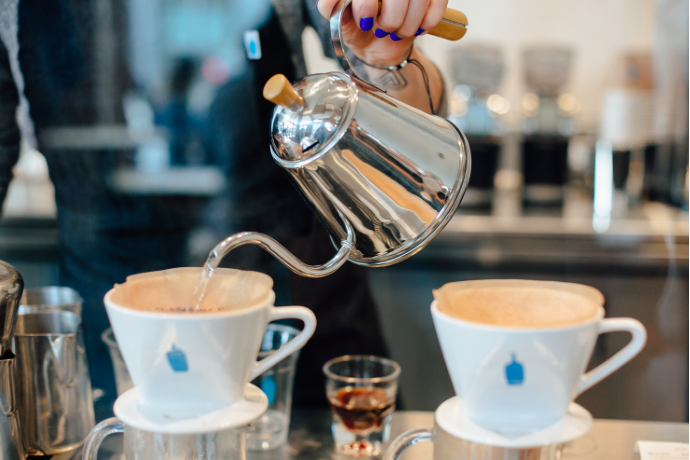The second wave of coffee: how does Starbucks sweep the world from New York to Taipei?

For professional baristas, please follow the coffee workshop (Wechat official account cafe_style)
Following the history of the first wave of coffee: who makes office workers have a drink with you no matter how busy they are? We discuss the emergence of the first wave of coffee and the story of instant coffee. This time Goat Coffee will take you to understand the second wave of coffee-the globalization of coffee chains.
What is the second wave of coffee?
The second wave of coffee is closely related to the globalization of coffee chains and represents the blossom and fruit of the "coffee enjoyment" culture around the world. If there is to be a clear definition, that is, from 1985 to 2005, with the emergence of a large number of American coffee chains, coffee culture took root in North America, and as Starbucks opened up its territory in the world, it will enjoy coffee. Italian coffee machine as the main form of expression, spread all over the world.
Different from the first wave of coffee, it is based on instant coffee, while the second wave of coffee takes "coffee shop" as the main body, emphasizing "the third place". "the third place" refers to another place between home and office, where people can enjoy the pure rhyme of coffee on the one hand, and do what they like to do on the other: reading books, reading newspapers, using pen and electricity. You can even work, meditate, and take a nap.
Overall, the second wave of coffee should be lazy and casual, so that people can have a unique occasion, belong to themselves, but also belong to others, enjoy their own life while enjoying the coffee.
The Origin of the Cafe
What is the origin of the coffee shop?
Coffee was first used in Africa, and with the expansion of the Ottoman Empire, North Africa was included in the territory, which also brought coffee into the Muslim world. Because Muslims are prohibited from drinking alcohol in the Koran, Muslim soldiers drink coffee before the war to achieve a refreshing and exciting effect.
In 1530, the first coffee shop in history opened in Damascus, the commercial hub of the Ottoman Empire, and became a good place for local residents to chat and activities. Soon, coffee shops spread and became popular in the Arab world, and over the next decade, coffee shops appeared in big cities such as Cairo and Baghdad, and even Constantinople, the capital of the Ottoman Empire.
At the same time, the Ottoman Empire continued to expand into Europe and, starting in 1529, besieged Vienna, the capital of the Holy Roman Empire, but was repeatedly repelled. In a failed offensive in 1570, Ottoman troops retreated and left a bag of coffee beans that were picked up by the armies of the Holy Roman Empire, which officially introduced coffee into Europe. Of course, the story is likely to be piercing, and it is more plausible to say that coffee spread to Europe in the mid-16th century with a deal made by Venetian merchants in Cairo.
In any case, in 1629, the first coffee shop in Europe was born in Venice, and Europeans have been crazy about coffee ever since.
The emergence of a chain of coffee shops
In the past, it was difficult for people to imagine the meaning of the word "chain". Because of the inconvenient transportation, it may take several weeks from Beijing to Nanjing, and the transportation time alone is too much for people to bear, let alone to set up stores in two places far apart. Management will be very difficult. Until the advent of modern means of transportation such as trains, which created the compression of time and space and greatly shortened the travel time, in 1858, the New York Tea Company of the United States established the world's first chain store.
The world's first coffee shop chain was once said to be the "Old S ã o Paulo Cafe" opened by Mizuno in Ginza, Japan in 1909. But the real emergence of a large number of coffee shop chains is in the United States.
In 1946, the Italian Gaggia improved the Italian coffee machine to make the coffee out of the cup faster and more efficiently, which laid the foundation for the prosperity of the coffee chain, because the speed of the cup determines the efficiency of the business. The Italian coffee machine was introduced to the United States by Italian immigrants, including Lino Meiorin, an Italian-American who invented latte, the most popular coffee flavor in modern times, at the Mediterranean Cafe in Berkeley, California, in 1950. The latte referred to here is a narrow latte with milk foam. If only the drinking way of adding milk to coffee had been invented by the Venetians as early as the 17th century)
Since then, coffee shops began to appear in large numbers in the United States, but there were not many coffee shop chains until 1971, when Starbucks was founded in Pike Market in Seattle.
Starbucks' global hegemony
At first, Starbucks only sells coffee beans. Although it has six stores in Seattle, the boss does not have much ambition and just wants to focus on selling coffee beans. But Howard Schultz, an employee in the store, doesn't think so. he has suggested several times that the boss should change his business model, but the boss is not interested. So Schultz resigned in 1985, opened his own Italian coffee shop called Daily Coffee, and went back to acquire Starbucks in 1987, opening the way for his coffee hegemony.
Starbucks dominated the American coffee market over the next decade and went public in 1992, becoming the first chain coffee shop in the world. What Starbucks focuses on is the "third place" mentioned above: simple store decoration, warm and comfortable space, where people can read books and newspapers and drink coffee.
In 1996, Starbucks opened its first overseas store in Japan. In the next decade, Starbucks expanded rapidly around the world at a more rampant pace. Starbucks can be found in Japan, China, Taiwan, India, Indonesia and even Europe, South America, Africa and Oceania. Today, Starbucks has 21000 stores worldwide, of which 12000 are in the United States.
A Starbucks in Korea
No one can deny that Starbucks did create the second wave of coffee. Had it not been for Starbucks, coffee culture would not have spread around the world as widely as it is today, from street corners in New York to businesses in Taipei to the streets of Seoul.
The attack on Starbucks
And perhaps the word "chain" is like a double-edged blade, which not only makes Starbucks hegemonic, but also makes it subject to a lot of criticism. The author does not describe these criticisms, but quotes a commentary published in the China Times on 2008-7-26:
". Starbucks shapes its image with noble taste of life to blur people's sense of consumption. Appealing to Starbucks coffee is tantamount to people with noble taste of life or even status, or people who know how to enjoy life. However, after removing this coat of hypocrisy, it is difficult to find its advantages. on the contrary, what we see is the exploitation of the people of the third World by the United States, buying coffee beans from them at oppressive and low prices, and then packaging them in a false consumer image. All we're selling is vanity. This exploits thousands of lower-class workers. "
Original website: http://www.coolloud.org.tw/node/24383
What is mysterious is that the coffee shop chain represented by Starbucks not only led the second wave of coffee, but its disadvantages also contributed to the rise of the third wave of coffee.
Important Notice :
前街咖啡 FrontStreet Coffee has moved to new addredd:
FrontStreet Coffee Address: 315,Donghua East Road,GuangZhou
Tel:020 38364473
- Prev

Blue Bottle Coffee "not doing business" actually sells "coffee cocktail"!
Professional barista communication please pay attention to coffee workshop (Weixin Official Accounts cafe_style ) Originating from Oakland, USA Blue bottle coffee is very popular. In the past, there have been many Blue bottle(Blue bottle coffee) branches in Japan. Arion Paylo, director of design and development department of Blue bottle coffee, said: "For the location of Blue bottle coffee, I only care about three things: this
- Next

Turn a corner, the hustle and bustle of tall buildings is completely isolated by time and space-old coffee
Professional barista exchange Please pay attention to the coffee workshop (Weixin Official Accounts cafe_style ) The hustle and bustle of downtown Taichung, surrounded by high-rise buildings, turned a corner, in the old style, all isolated by time and space. Once, Yamato Road was a row of old Japanese-style bungalows, but now most of them have been replaced by sky-high buildings. However, after renting the remaining old house, the old sample decided to convert this rare simplicity.
Related
- What documents do you need to go through to open a coffee shop? coffee shop coffee shop certificate processing process
- How to purchase Coffee beans in small Cafe how to choose a suitable supplier for domestic Coffee supply Company
- How to drink Starbucks Fragrance White Coffee? how to make Australian White Coffee? what Italian coffee beans are recommended?
- The Story of Flora Coffee: the name of Flora Coffee Bean and the implication of the Flowers on Florna Coffee
- How much does a cup of coffee cost? How much is the profit of a cup of coffee? What is the profit of the coffee shop in a year?
- Yunnan small Coffee, known as "fragrant Coffee", introduces the characteristics of Alpine Arabica Coffee producing areas in Yunnan, China
- 2023 latest Starbucks full menu price list how much is a cup of Starbucks coffee what is better to drink the most popular hot and cold drinks recommended
- Starbucks different kinds of Coffee Price list Starbucks menu 2023 Top Ten Best drinks in Starbucks
- Starbucks Spring praise Comprehensive matching Coffee Bean theme Story Packaging implication and taste description
- The cost of a cup of coffee latte American coffee cost price and selling price

